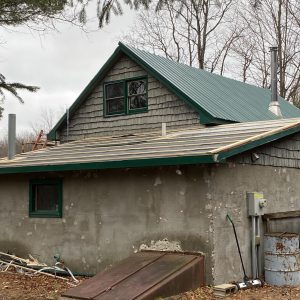siding for a cinder block cottage
I am interested in re-siding an old cinder block cottage. Currently the cottage has an old layer of foam insulation covered with a VERY thin layer of cement. The resident woodpeckers and chickadees have had a field day drilling holes thru the thin cement and creating huge holes in the foam insulation. Now there are some red squirrels setting up homes/nests within these holes. I have a builder friend who will be doing the work….he put on a new metal roof last fall and this spring will begin the outside reno work….new windows, an addition both front and back and the siding. I am still undecided about the siding…the inside of the cottage is just the bare painted concrete blocks. Do i insulate the inside or the outside? Do I stucco or do I have my builder install metal/wood/vinyl siding???? This cottage is deep in the woods….in a northern Michigan climate so it is heated primarily with a wood stove and there is a propane furnace to supply secondary heat as necessary. The cottage sits on a slab foundation…there is no basement. It is primarily a one story with a small loft. A low ceiling on the main floor. I seem to be immobilized by all the choices for siding….and how to insulate so am hoping the professionals and wise folks on this forum can steer me in some creative directions. Many thanks for any advice/guidance/wisdoms




















Replies
seems like termites would get into the foam- sort that out-- also had a friend who had to remove foam near the ground 18 inches? due to termite threat.
my builder and i are still trying to decide whether to remove the thin cement shell and all the old foam or to just fill the woodpecker holes with expandable foam and then do the siding. What are your thoughts?
Depends on the condition of the foam.
would be good to use it for a while vs sending to the landfill.
You know the forest is home to a lot of creatures, which like to live and snack on whatever they can find.
My late ex father in law built a place in the woods (a "camp" in the western UP) he made the walls/siding of textured plywood and ended up covering it with metal mesh and a thick coat of a cement product because the local porcupines liked the plywood so much.
Look around for other cabins and see what seems old and in good shape. Would vinyl hold up to the critters and falling woodsy debris?
a proper mesh or at least fiber containing stucco would be good, and metal siding for walls can perform well. (but the metal needs air circulation behind it, which also might let more critters into the wall)
What are you going to side the additions with? And what are your plans for the inside of the additions?
You could also make a case to strip the outside to the block, then parge (even with a fiber to help hold it together). then frame and insulate the inside of the block walls to match whatever you plan to do the interior with.
No basement, but a bulkhead door? The stairs to nowhere? :-) How thick is the foam, and what kind is it? Depending on how difficult it is to remove the parging, and how much you'd lose in your overhang, you could add more rigid insulation if you need it right over the cement and then parge that new foam layer using wire mesh to fight the critters off, and give a good bite for the parging. If you wanted to use a different siding material you might want to think about strapping and insulating between the strapping to keep the depth down. I can't say whether adding insulation to the inside while having the cinder block between that and the exterior foam is a good idea. If you wanted to insulate inside, and also think, or learn, that you should remove the exterior insulation to do that, you'd be reducing your interior space by quite a lot to get the R value you need in that climate. At minimum you be losing a foot in each direction, more if you insulate to code. If you have 2 inches of foam on the outside, adding 2 more inches will get you close to minimum recommendations, depending on whether you're in climate zone 6 or 7 in the north. The other variable is what kind of foam is already there. Tests have shown that polyiso performs less than ideally in cold climates, especially if it's used on the exterior.